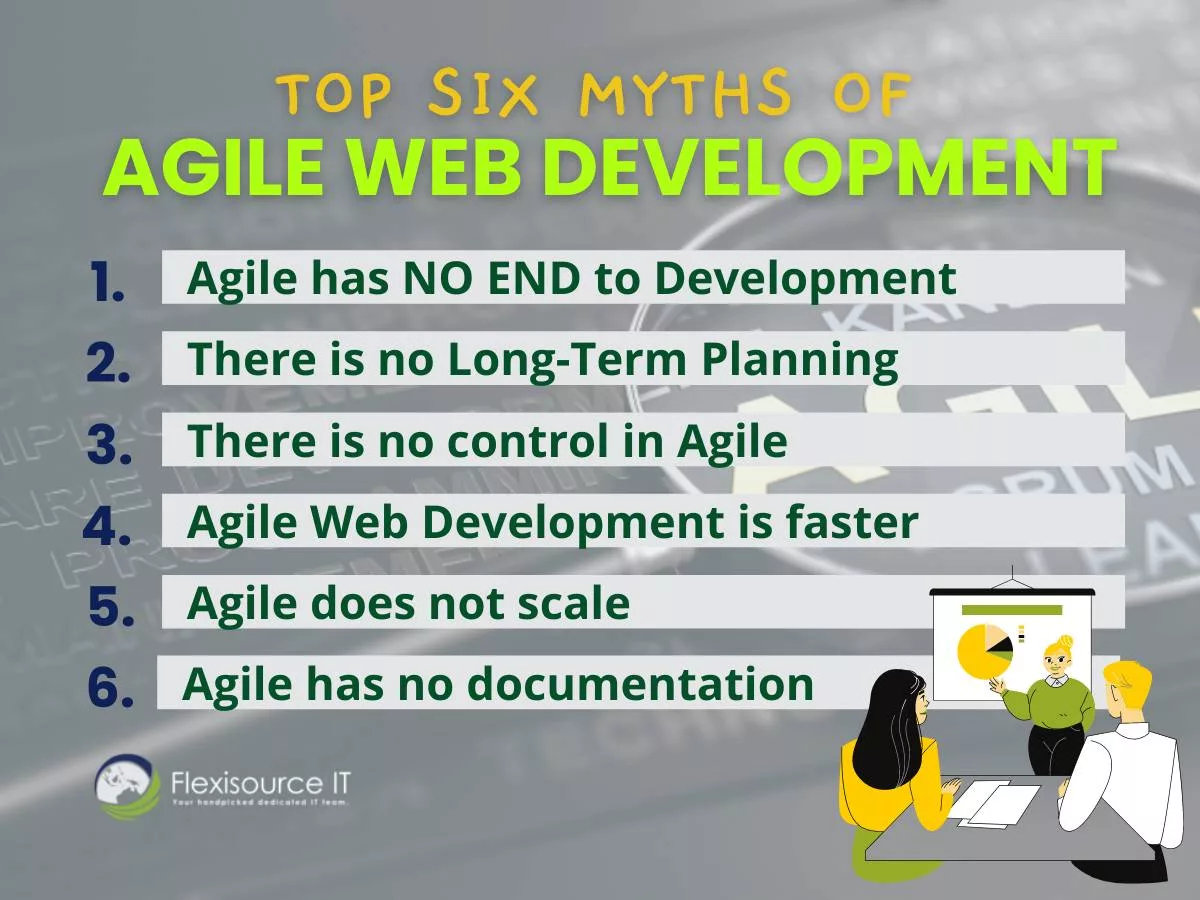Agile development methodology has revolutionized the project management of many IT companies for years. It is becoming one of the most defined projects management methods and is adapted by most IT outsourcing companies worldwide.
Agile has benefits that fit software and web development, such as sprints. In contrast, companies can integrate changes compared to the traditional waterfall method. However, like other methodologies, Agile web development also comes with drawbacks.
Project managers and business leaders are sometimes hesitant and doubtful of Agile. To fully understand and debunk these accusations, it is essential to understand agile.
What is Agile Web Development?
Agile Web Development is a development process based on the shared practices of Agile Software Development. The method uses “sprints,” or short development cycles, to provide customers with the best product. Each sprint includes discovery, design, development, testing, and feedback.
The main goal of this practice is to provide flexibility to customers throughout the development of the software or application by integrating feedback and changes in each sprint. Another goal is to fasten service delivery by dividing the project into several stages. In each step, the company can release parts of the product completed, tested, and modified one by one while remaining for the other details of the project to finish.
In addition, here are some benefits of Agile Development and why leading companies are adopting it for managing their IT projects:
- Reduced Risks
- Increased ROI
- High-Quality Product
- Increased flexibility to changes
- Improved task and business predictability
- Improved Team Morale
- Better control
Top 6 Myths of Agile Web Development
Agile Web Development has made its way into the information and technology industry in the past years. As the demand, pressure, and competitiveness increase, many software companies must turn agile to fast-track the delivery schedule of many applications and attain goals.
However, as more organizations turn to Agile Development, tech leaders cloud its actual definition and goal. Most tech leaders have tremendous fear and doubt with Agile compared to the traditional project development method. Many other project leaders are misled by the Agile Myth and Rumors released.
To debunk these buzz tales, here are Agile Software Development Myths and what the data says:

1. Agile has NO END to Development
Due to its reiterative feature, many developers referred to Agile as the “code-and-fix” method. One Agile myth is that its development includes a never-ending fixing, changes, and application cycle. Continuous integration, test-driven software development, and refactoring usually do not indicate a disciplined methodology. Most of these practices are associated with Agile.
However, it is essential to remember that Agile development is a constant delivery of product parts. It is to ensure that the team is delivering what the client needs. Several definitions of Done (DoD) for the agile project include DoD for a feature (story or product backlog item), DoD for a Sprint (collection of attributes developed within a sprint), and DoD for a release (potentially shippable state.
Almost all development teams can benefit from this practice and automate their delivery sequence and discipline. Most Agile methods have been around for decades as a collection of interdependent practices. In addition, these practices have helped the developing team practice a high level of collaboration and management discipline.
Aside from that, these collective sprints enable stakeholders or product owners to be a part of the development team. It helps them plan out and envision the product goals along the way.
2. There is no Long-Term Planning
Another Agile myth popular with Agile is that it does not have “Long-Term Planning. Agile planning comes with a more iterative approach, using sprints. Usually, Agile Planning is mistakenly rotated only on these prints. Thus, people think that Agile is only for short-term development. They believe that nothing comes after each sprint.
In reality, Agile project planning also requires preparation and other methodology. Before starting an Agile Project, the team is not necessary to do considerable up-front planning. Usually, product owners have a rough sketch of what they hope to develop. Typically, the plans consist only of the main objective, timeline, budget, and roles to guide them throughout the whole cycle.
The team leader distributes Agile planning throughout the development exercise rather than at the front. The long-term planning in Agile is called release planning. It comprises rough estimates and the velocity of a commitment and how they relate to the major themes of the project.
3. There is no control in Agile
One Agile Myth for managers when turning to Agile is losing control of their team. Many believe that Agile is anarchic because the team is self-organized. Agile gives individual developers the freedom to organize and perform their tasks individually.
In Agile, the manager’s role is to ensure that the teams achieve goals and objectives without constraints. The managers deal with the blockers faced by the team members. In addition, project managers also assign the tasks to the developers. It is their agile roles that are clear and well-defined. When the parts are restricted, the product owner and project manager have nothing to be afraid of and should encourage this process in the face. Agile is a shared commitment of a team and not individually.
The management’s role does change in Agile, but they still play a crucial role. The manager’s role is to make sure that the goals, and visions. When these roles are well-defined, it will be easy for the team to be self-organized. So, in reality, there is nothing to be afraid of in self-organization. It should often be encouraged to make the manager’s work more manageable and the process more effective.
4. Agile Web Development is faster
Another Agile Myth that we hear about is agile is faster. However, Agile does not necessarily mean faster. Agile consists of iterate planning, story writing, backlog cleaning, retrospective meetings, and daily standups when adequately planned. This amount of work itself can take a considerable amount of time.
However, agile divides its product delivery into different stages throughout the development cycle. It can help the product owner use or release parts of the functional and good product.
Aside from that, the “sprint” does not necessarily means completing the product faster. While the product owner may release parts of the product, the quality takes time to accomplish. The Agile methodology ensures that apps have lesser bugs to fix and that the software is sustainable. Agile aims to minimize waste and counter-productivity. This method aims to create a high-quality product and not meet the deadline.
5. Agile does not scale
“Agile does not scale” is another Agile myth we often hear from project managers. Based on its conceptual framework, Agile Web Development is often believed not to be scalable and only great for small projects and not huge, complex products.
Regardless of the approach, however, scaling a development is complex. For agile, scaling is a debatable subject. Developers cannot sustain agile in large projects involving multiple teams for some people. However, many open source program developers think that Agile is remarkable, considering its iterative nature.
Agile breaks immense, complex products into small, manageable pieces. It means that agile is scalable – even for significant developments. However, it is also important to tweak your agile practices to fit the realities of big projects. For example, the bigger the development team, the shorter the development cycle should be. Moreover, daily face-to-face standups should be limited to large projects and virtually. It will be easier to track when done via this communication.
6. Agile has no documentation
Many developers think that Agile has no documentation. Organizations probably took this Agile Myth out of context from the Agile Manifesto. It states: “We value working software over comprehensive documentation.” However, the manifesto did not explicitly say that documentation is not necessary. The manifesto says that the development team should focus on producing the software instead of spending too much on creating and documenting the project.
Some agile leaders encourage developers to document any changes done to the product. It is an essential aspect of development since misunderstanding between the developer and the product owner is always prevalent. As such, agile allows business-driven and beneficial documentation production, enabling the technical team to develop the product effectively and efficiently. Inability to produce the necessary documentation can be a classic example of technical debt.
Aside from that, Agile development generates a tremendous amount of documentation than the Big Designs Up Front (BDUF) method.
Conclusion
In summary, myths and criticism should not cloud your judgment. Agile is not a fad. It has its strengths that will likely help you in your development journey. We hope that this article has helped you understand more about Agile and reconsider your biases toward it. Regardless of your methodology choice, project development necessitates planning, expertise, and experience.
If you are looking to hire highly skilled developers and experts in Agile Development, contact Flexisource IT!





